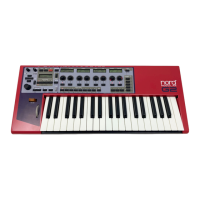NORD MODULAR G2 V1.1 12. Synthesis basics: The oscillators and waveforms
Page 203
• By Modulation. Modulation allows you to make the pitch vary “automatically”. The most common
example is probably to use an LFO to make pitch go up and down, to create a vibrato. But you can
also put the pitch under envelope control, or make the pitch vary with your striking force (velocity).
W
WW
W
A
AA
AV
VV
VE
EE
EF
FF
FO
OO
OR
RR
RM
MM
M
The waveform of the oscillator affects its harmonic content and thereby its “characteristics” (timbre). The
three most common waveforms are sawtooth, pulse wave and triangle.
Looking at the shape of a waveform tells very little about how it sounds. Instead, there’s a better way to
draw it, called a spectrum. Let’s introduce some quick theory:
Mathematically, all waveforms can be considered as built from a number of harmonics, added together.
Each of the harmonics consists of a sine wave, the purest and simple waveform there is (a sine wave has
no harmonics at all). In other words, if you add a number of sine waves together, each one with its own
pitch (frequency) and volume (amplitude), then you can build any waveform you like.
The lowest harmonic is called the fundamental. The fundamental determines the basic pitch of the sound.
If the fundamental has a frequency of 440Hz, we will perceive the entire sound as having a pitch of
440Hz.
Other harmonics are then added to the fundamental, called overtones. Normally the first overtone appears
at a frequency twice the fundamental (in our example 880 Hz). The next harmonic appears at a frequency
three times the fundamental (in our example 1320Hz) and so on.
In a spectral display of a waveform you can see the frequency (pitch) of each harmonic and its amplitude
(level). This is done by drawing each harmonic as a line raising up from a horizontal scale.
Each line’s position on this scale indicates the harmonic’s frequency. The line furthest to the left is the
fundamental, the next is the first harmonic etc. To make life easier, one usually doesn’t label the horizon-
tal scale with frequency in Hz, but rather with the number of the harmonic.
The height of each line represents the amplitude of each harmonic.
If you understand the principle, you also understand that if the harmonics with high numbers have a high
amplitude, the sound will be perceived as bright.
Let’s take a look at some common waveforms and their spectra.
In the illustrations below, only some of the first harmonics are displayed. In reality, waveforms like these
have an infinite amount of harmonics.
S
SS
S
A
AA
AW
WW
WT
TT
TO
OO
OO
OO
OT
TT
TH
HH
H
The Sawtooth wave has a simple spectrum. All harmonics are present in the wave, in proportional values.
As you can see, the high harmonics have a fairly high amplitude, which makes this waveform sound
bright.

